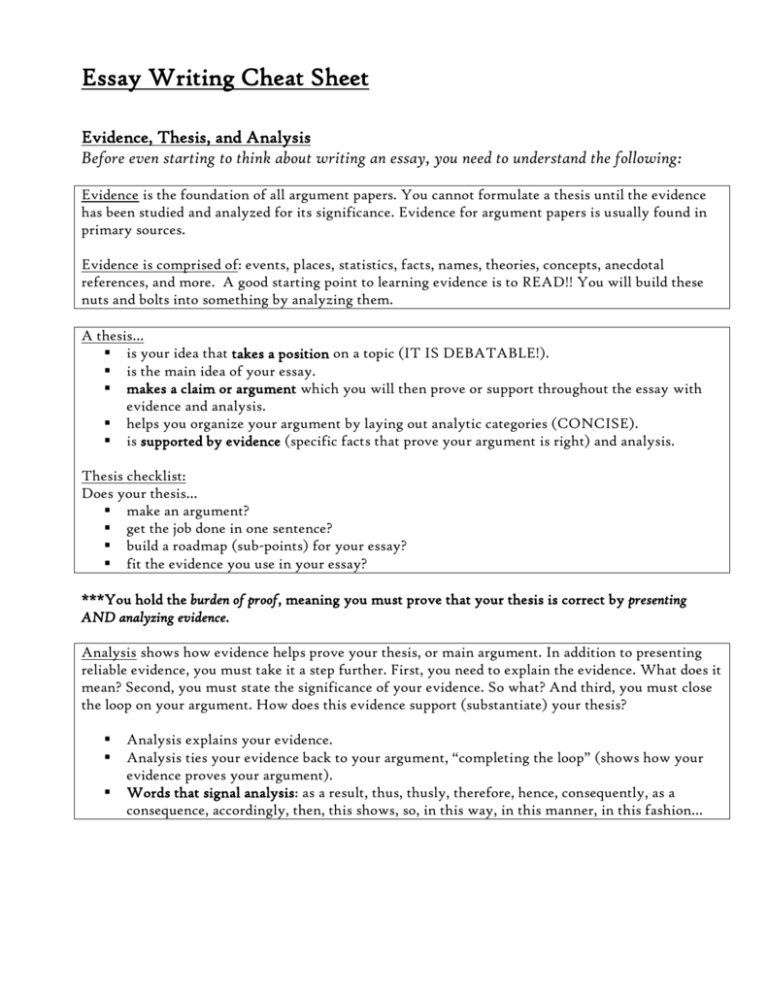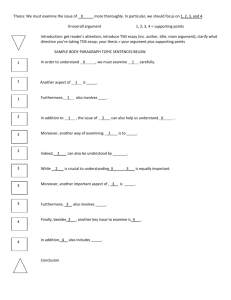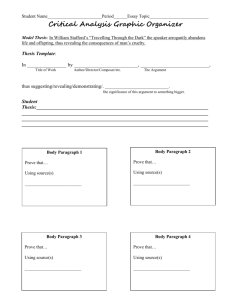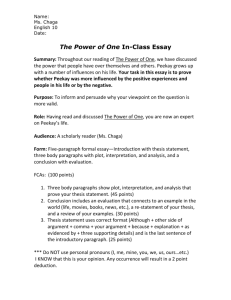Essay Writing Cheat Sheet
advertisement

Essay Writing Cheat Sheet Evidence, Thesis, and Analysis Before even starting to think about writing an essay, you need to understand the following: Evidence is the foundation of all argument papers. You cannot formulate a thesis until the evidence has been studied and analyzed for its significance. Evidence for argument papers is usually found in primary sources. Evidence is comprised of: events, places, statistics, facts, names, theories, concepts, anecdotal references, and more. A good starting point to learning evidence is to READ!! You will build these nuts and bolts into something by analyzing them. A thesis… is your idea that takes a position on a topic (IT IS DEBATABLE!). is the main idea of your essay. makes a claim or argument which you will then prove or support throughout the essay with evidence and analysis. helps you organize your argument by laying out analytic categories (CONCISE). is supported by evidence (specific facts that prove your argument is right) and analysis. Thesis checklist: Does your thesis… make an argument? get the job done in one sentence? build a roadmap (sub-points) for your essay? fit the evidence you use in your essay? ***You hold the burden of proof, meaning you must prove that your thesis is correct by presenting AND analyzing evidence. Analysis shows how evidence helps prove your thesis, or main argument. In addition to presenting reliable evidence, you must take it a step further. First, you need to explain the evidence. What does it mean? Second, you must state the significance of your evidence. So what? And third, you must close the loop on your argument. How does this evidence support (substantiate) your thesis? Analysis explains your evidence. Analysis ties your evidence back to your argument, “completing the loop” (shows how your evidence proves your argument). Words that signal analysis: as a result, thus, thusly, therefore, hence, consequently, as a consequence, accordingly, then, this shows, so, in this way, in this manner, in this fashion… Seven Steps of Synthesis Essay Writing 1. Read and analyze the claim 2. Collect and sort the data needed to answer the question Make sure your graphic organizer has sub-point categories. Brainstorm a list of factual information within your graphic organizer. 3. Create your thesis statement The thesis is your answer to the question. It is the guiding argument of the essay. The thesis must fully address the question, take a position with regard to the question, and provide organizational categories for analysis (2-4 sub-points). 4. Write the introduction to your essay OVERVIEW: taken from the claim - who, what, when, where Analysis statement: taken from the claim – why, how Thesis statement: your answer to the question (as analytical and evaluatory as you can possibly make it, including all sub-points listed briefly) 5. Write the body of the essay Each paragraph MUST have a topic sentence (introducing the sub-point for that paragraph and what your argument is about it) Each paragraph must have evidence FROM MULTIPLE SOURCES. This is the necessary ingredient to prove that your thesis is correct. Aim to include at least 3 supporting facts. Each paragraph must have analysis, which explains how your piece(s) of evidence prove your thesis. You can either BLEND YOUR EVIDENCE and ANALYSIS into the SAME SENTENCE, or, you can write ONE EVIDENCE SENTENCED FOLLOWED BY ONE ANALYTIC SENTENCE…and repeat. Each paragraph MUST end with a linking sentence that directs the reader to the next paragraph (it contains your sub-point plus argument about that sub-point for the above paragraph and compares/contrasts it with the next paragraph’s sub-point/argument). 6. Write the conclusion Start with a “concluding phrase” Restate your thesis statement a bit differently. The conclusion must summarize the main points of the body paragraphs. The conclusion must synthesize the linking sentences. The conclusion must address “so what?” (significance): 1. End of some trend/movement/idea, etc. 2. Beginning of some trend/movement/idea, etc. 3. Endo of one and beginning of another 4. Do NOT end on the note that this is the reason we are where we are today! 7. Proofread your essay Eliminate grammatical errors and contradictions between the thesis and the body. Try to add in any further details (NAMING specific facts, people, events, phenomena…). Transition and Signal Words for Essays *Always spell out full names first, then use abbreviations or last names only thereafter.* Sequence and Chronological Order Stems After (the) final Afterwards First, first of all Ago Following Already For a time At last Further, At the same time furthermore As Immediately Before Initially During In the first place Eventually In the meantime Even now Last, lastly Finally Later Long after Meanwhile Next Now Not long after Once On (date) Preceding Presently Second, secondly Several Sometimes Soon, soon after Some Subsequently Suddenly Then Thereafter Third To begin with Today Until While Compare and Contrast Stems Although Even though Also Equally As opposed to important As well as However But In comparison By comparison In contrast Compared with In like manner Conversely In the same way Despite In spite of Different from Instead of Either…or Just as Like Likewise Neither…nor Nevertheless Notwithstanding On the contrary Not only…but also On the other hand Rather then Regardless Same as Similarly Still Unlike Unless Whereas While Yet Cause and Effect Stems Accordingly As a result As if As though Because Consequently Hence In order to If…then It follows that May be due to Nevertheless Provided that Since So So that Then Therefore Thus Emphasis Words Besides Certainly Furthermore Indeed Moreover Obviously Of course Stems for Examples Another For example For instance Furthermore First, second, etc… In addition Most important Namely Specifically Such as To begin with That is To illustrate Conclusion Words As a result Consequently For this reason In brief/short In other words It follows that In fact On the whole Therefore Thus To summarize To sum up








